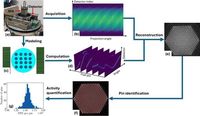The Passive Gamma Emission Tomography (PGET) instrument, authorized by the International Atomic Energy Agency (IAEA), has evolved to become an essential tool in the verification of spent nuclear fuel assemblies (SFAs). This advanced technology aims not only to create accurate two-dimensional images of SFAs but also to identify missing or present fuel pins and quantify their activities. Recent advancements, particularly a new linear inverse approach, have addressed the common challenges of self-shielding and scattering effects, leading to improved image quality and identification accuracy in simulation studies.
The PGET system operates with two arrays of tungsten-collimated high-energy-resolution cadmium-zinc-telluride (CZT) detectors that detect gamma rays emitted by long-lived fission products in spent fuel, specifically elements like cesium-137 (137Cs) and europium-154 (154Eu). These detectors revolve around the fuel assembly and collect counts of gamma emissions from different angles, generating a sinogram—a crucial step for visualizing emissions in a two-dimensional form.
An innovative linear inverse methodology has refined the image reconstruction process by framing it as an inverse problem reliant on a physics-based forward model of the PGET system. "This approach frames the image reconstruction process as an inverse problem, relying on a physics-based forward model of the PGET system," wrote the authors. This enhanced model incorporates intricate interactions of photons, accounting for both photoelectric absorption and Compton scattering, significantly elevating the reliability of quantification of fuel pin activities.
One of the groundbreaking aspects of this new model is its rapid computational capability. By augmenting the forward model to simulate near-real-time sinograms and system matrices, researchers have improved the speed of simulations by over 100,000 times compared to traditional 3D Monte Carlo simulations. This remarkable increase in processing efficiency allows for faster turnaround in analysis during inspections—and critical for the safety protocols mandated by the IAEA.
The validation of the forward model was a significant milestone. The researchers found only a 3.7% relative difference in counts between their model and Monte Carlo simulations—demonstrating high accuracy. This capability was further manifested when the reconstruction method was applied to real data gathered from a measurement campaign conducted in Finland in 2021. The PGET system effectively imaged all the pins of the VVER-440 spent fuel assembly under investigation, including those located in the most difficult-to-access water channel.
"The high accuracy and low computational cost of our forward model demonstrate its potential for real-world inspection scenarios and enable future algorithm development," the authors emphasized. With an average uncertainty in activity quantification certified at 2.3%, the developed model shows a meaningful advancement in safeguarding measures for spent nuclear fuel—essential for preventing scenarios of fuel diversion.
The findings underscored the importance of continuous improvement in nuclear safety technology, addressing pressing concerns around the verification of spent nuclear fuel. Historically, the challenges of software-intensive simulations and long processing times had limited the efficacy of nuclear inspections. Consequently, the PGET advancements contribute to a broader push within the nuclear energy community to develop tools that are not only efficient but also capable of providing precise insights into the conditions and security of nuclear materials.
Through rigorous methodology and advanced modeling techniques, this research positions PGET as a leading instrument for future inspections in the realm of spent nuclear fuel verification. Given the growing emphasis on nuclear security worldwide, this innovative approach provides a new benchmark for operational confidence and regulatory compliance within the nuclear sector.

